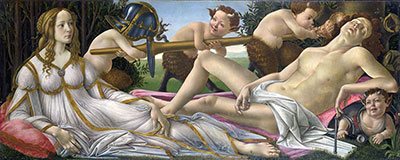 Buy Art Prints Now
Buy Art Prints Nowfrom Amazon
* As an Amazon Associate, and partner with Google Adsense and Ezoic, I earn from qualifying purchases.
Mars and Venus is one of the best-known paintings by Sandro Botticelli, painter of the Italian Renaissance, who worked in Florence in the latter part of the fifteenth century.
Botticelli painted it in approximately 1483. Venus, the Roman goddess of love, had many lovers, one of whom was Mars, the Roman god of war. The painting shows Mars asleep, presumably exhausted by his lovemaking with Venus. Venus however, is awake and watchful, presumably revelling in her conquest.
Mars has abandoned all the accoutrements of a soldier and several little satyrs are playing with his armour. The painting is an allegory, in which various levels of meaning and symbolism can be found.
Satyrs were creatures of Greek mythology, known for their lustfulness and playfulness. They were thought to inhabit woods and countryside and to be followers of the ecstatic cult of Dionysus. The audience looking at this painting would have been well aware of what the satyrs signified.
The satyr in the bottom right hand corner of the painting has attracted some attention in the art history world, because of the curious fruit under his hand. It has been suggested by art historian David Bellingham that this is datura stramonium, a hallucinogen, and that Mars is in fact in a drugged sleep. Experts at Kew Gardens in London, have confirmed that the plant is indeed datura.
However, the interpretation and significance of this are still being discussed. Since the fruit in the Bible is not named as an apple, there may be a Biblical reference here, with an attempt to remind the audience of Adam and Eve – note that Venus is actually modestly dressed. The key point is that like many paintings, this one has layers of meaning and is open to many different interpretations.
The satyr at bottom right in the picture, is inside a part of Mars’s armour – the breastplate. In the centre of the picture, providing a strong line across it, is the God’s lance, with a helmet at the end – all sexual allusions to show that Mars is disarmed and conquered by love. One of the satyrs is blowing a shell horn in the God’s ear to try and wake him.
The couple are lying among myrtle trees. The myrtle was the tree of Venus, and was considered an especially strong aphrodisiac; Roman brides would carry myrtle in their bridal bouquets. There is also a laurel bush – laurel was the symbol of the Medicis in Florence so this may be a subtle nod in their direction.
Look carefully at the right of the painting, above the head of the sleeping Mars, and you’ll find a number of wasps. There are several schools of thought about the significance of the wasps. One school says that they are to show that Mars has been stung by love’s dart, another that because Venus is married and the love is illicit, the sweetness has a sting in its tail.
Others point to the woman who was the model for Venus. She was Simonetta Cattaneo de Candia. She was reputed to be the most beautiful woman in Florence at the time and Botticelli painted her in two of his most famous paintings – Primavera and the Birth of Venus. She was married to a member of the powerful Vespucci family. The Italian word for wasp is “vespe” and they feature on the Vespucci coat of arms. So there may be a subtle compliment being paid to Simonetta’s Vespucci husband.
On the other hand, we come back to the fact that Venus was committing adultery with Mars. Simonetta was popular at the Medici court because of her beauty and knew the Medicis well. Some commentators have pointed to the likeness between Mars and the man depicted in Botticelli’s portrait of Giuliano de Medici, which was painted in about 1477.
There is certainly a disparity in the treatment of the two figures in the painting. Venus is depicted fully clothed, in contemporary costume. Mars on the other hand, looks as though he is painted from a marble statue.
This work was painted on poplar wood, in tempera and oil. Tempera was a paint made by grinding pigments to a powder and adding them to a medium such as water, honey or egg to make a workable paint.
The painting is a little under 70 cms tall and 175 cms wide and was probably intended to be used as a headboard panel on a bed. However we know very little about who commissioned the work or why. We do know that Botticelli’s patron was Lorenzo de Medici and that by 1470 Botticelli was established in his own workshop.
We also know that when he was older, Botticelli followed the monk Girolamo Savonarola who preached a deeply moral message. As a result, Botticelli’s later work became increasingly devout.
After his death, Botticelli was not popular again until the latter part of the nineteenth century. The National Gallery in London bought five of his paintings between 1857 and 1878, and these included Venus and Mars.
Sandro Botticelli asked to be buried at the feet of Simonetta Cattaneo de Candia when he died. His wish was granted nearly thirty five years later, at his death in 1510. Simonetta was buried in the Vespucci family church, the Church of Ognissanti, and a round stone now marks the place where Botticelli was buried, at her feet.




